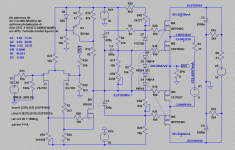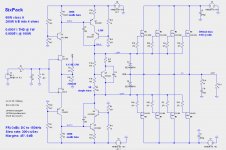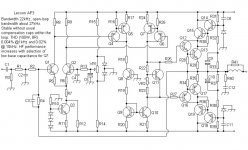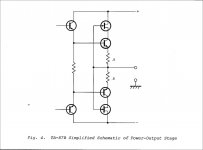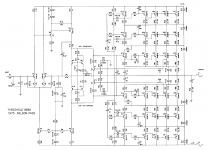If the first stage's gain is ~1 then all of the amplifier's gain comes from the second stage. Will that be enough?
Also, the second stage's noise contribution is divided by the first stage's gain. Since the first stage's gain is ~1, the amplifier will be noisier.
I use a DIY HPA-1 for a preamp, which can deliver a very hot signal. So the 21dB of gain I'm getting is plenty.
The noise issue is not good, though. Probably better to drop the feedback voltage divider and just put in some bigger resistors....
Hmm... does an AC analysis work here? The input stage is converting a voltage signal into a current signal (which the VAS then turns back into voltage). I'm not even sure what the definition of "gain" is in the middle of that....
Usually the target gain for a modern power amp is about 27-30db.
So who is going to volunteer to layout the pcb for the amp?😀
Jam
So who is going to volunteer to layout the pcb for the amp?😀
Jam
Last edited:
I bumped up the gain a bit on both Beefcake and SixPack (now 25dB).
Lowering the feedback required compensation changes to both designs: more phase lead comp for Beefcake, and more feedback current for SixPack.
The greater feedback current requires paralleling a bunch of resistors (under the assumption that metal oxide and wirewound aren't appropriate here). But it has the twin side benefits of making the offset adjustment less finicky and dropping the distortion by 1/2.
Lowering the feedback required compensation changes to both designs: more phase lead comp for Beefcake, and more feedback current for SixPack.
The greater feedback current requires paralleling a bunch of resistors (under the assumption that metal oxide and wirewound aren't appropriate here). But it has the twin side benefits of making the offset adjustment less finicky and dropping the distortion by 1/2.
Hmmm... SixPack doesn't really fit into a stereo chassis. With shunt regs on the front end we're looking at having to dump 200W a channel.
Going to a mono-block design doesn't fit well with having 3 pairs of output devices (as one side would have to have 1 and the other side 2). The obvious answer would be to go to 4 pairs of outputs, but EightPack doesn't have the same ring.
Pass XA-style heatsinks on a large stereo chassis might be another option....
Going to a mono-block design doesn't fit well with having 3 pairs of output devices (as one side would have to have 1 and the other side 2). The obvious answer would be to go to 4 pairs of outputs, but EightPack doesn't have the same ring.
Pass XA-style heatsinks on a large stereo chassis might be another option....
Or mono-blocks in 4-sided Aleph-style cases with one output pair on each of 3 sides and the shunt regs on the 4th....
(Pity the Aleph-style heatsinks are so expensive....)
(Pity the Aleph-style heatsinks are so expensive....)
I'm biasing them into their negative temp-co area. 625mA, which is about 29W at idle. 3 pairs gives an 80W class A envelope into 8 ohms; 50W into 4.
I'll turn them off for both days of summer in Ireland....
I'll turn them off for both days of summer in Ireland....
Hmm... I think it needs 4 pairs of output devices anyway. Otherwise clamp diodes won't allow both full power and brief short survivability.
(4 pairs at the same bias allows a 100W class A envelope into both 8 and 4 ohms. Might have to rename it Scotch Bonnet.)
(4 pairs at the same bias allows a 100W class A envelope into both 8 and 4 ohms. Might have to rename it Scotch Bonnet.)
I'm studying cascode output stage. Output pair is Class A and cascode will do ~ 8W in class A and continues to ~ 30W in AB, needs about 30W of heatsink capacity per channel. What do you guys think?
Attachments
...
I'll turn them off for both days of summer in Ireland....
That's funny 😀
This is one of the most entertaining threads. Thanks for letting us spectate and I'm super curious to see how it turns out (and sounds).

Jeff,
That is kinda toasty............
Depending on the rails I would start with about 100mA per output pair and increase the bias slowly till you find a point where the is little sonic difference and stop. (not to exceed 50 deg.C)
The cascode output stage as a problem in perceived compression in listening tests that being said bipolar cascodes work best if you have to use them.
My humble opinion is to avoid a cascoded output stage and add more devices in parallel if you have to.
Jam
That is kinda toasty............
Depending on the rails I would start with about 100mA per output pair and increase the bias slowly till you find a point where the is little sonic difference and stop. (not to exceed 50 deg.C)
The cascode output stage as a problem in perceived compression in listening tests that being said bipolar cascodes work best if you have to use them.
My humble opinion is to avoid a cascoded output stage and add more devices in parallel if you have to.
Jam
Attachments
Last edited:
Me either, I’ve been pondering about how to replace it...
Ditto, been thinking about Jung's GLED431 + opamp, add a shunt output transistor, make R2 & R4 adjustable, temp stability wouldn't an issue, a thermistor is needed anyway. It would then be a matter of finding a suitable opamp to work over a 3V to 12V range.
The junction of R3 & R4 present the opportunity to servo the dc offset... I know, it's getting messy.
...but EightPack doesn't have the same ring...
You could keep the name if you went 6 deep.
An update.
Corrected the Vbe bypass cap (the bypass should not include the Hawksford compensation resistor).
Added current limiting.
Increased the bias adjustment range. (I'll say one thing: the TL431 is a damn sight easier to adjust....)
Added another output pair and lowered the target bias. Not nearly as much as Jam suggested because I'm still trying to get into Pico's FAB club. 😀

Tempted, I am.
Cheers,
Jeff.
Corrected the Vbe bypass cap (the bypass should not include the Hawksford compensation resistor).
Added current limiting.
Increased the bias adjustment range. (I'll say one thing: the TL431 is a damn sight easier to adjust....)
Added another output pair and lowered the target bias. Not nearly as much as Jam suggested because I'm still trying to get into Pico's FAB club. 😀
You could keep the name if you went 6 deep.
Tempted, I am.
Cheers,
Jeff.
Attachments
Knowing Jam as I do, suspect he is trying to remain low key with recommendations. Imagine he would probably hint a bit more strongly offline. One could always PM to see if a phone call might be worthwhile.
Knowing Jam as I do, suspect he is trying to remain low key with recommendations. Imagine he would probably hint a bit more strongly offline. One could always PM to see if a phone call might be worthwhile.
The new adjustment range will cover Jam's suggestion.
One of the reasons I like designing with the higher point in mind is that without temp compensation the output stage could theoretically run away up to the negative temp-co point (which is roughly 625mA). If that's within my design envelope then no worries....
Cheers,
Jeff.
More in general was my thought, not necessarily the last one. Could be interesting. Up to you 🙂
Thank you for the comment Jam. In your experience, where would the compression be most apparent, loud, soft or dynamic pasages?... The cascode output stage as a problem in perceived compression in listening tests ...
indra,
This effect is more apparent in orchestral climaxes, you can still detect it during low level passages.....while it does not sound bad it makes the music sound more polite for want of a better word to describe it's effects. There was also the issue of stability.
My first instance of running across a cascoded output stage was a Lecson amplifier designed by Stan Curtis (I owned one) and was used to limit the dissipation of the output devices because they weren't that good back in the day.
Sony later used it (for different reasons) and Nelson Pass used it in the Threshold 800.
The idea never really caught on except in some high power applications.
Jam
This effect is more apparent in orchestral climaxes, you can still detect it during low level passages.....while it does not sound bad it makes the music sound more polite for want of a better word to describe it's effects. There was also the issue of stability.
My first instance of running across a cascoded output stage was a Lecson amplifier designed by Stan Curtis (I owned one) and was used to limit the dissipation of the output devices because they weren't that good back in the day.
Sony later used it (for different reasons) and Nelson Pass used it in the Threshold 800.
The idea never really caught on except in some high power applications.
Jam
Attachments
Last edited:
- Home
- Amplifiers
- Pass Labs
- JamJar: an HPA-1-inspired power amp
